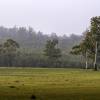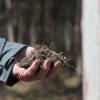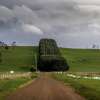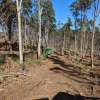
Napier's leading the way in sustainable forestry and carbon-neutral farming
Posted 17 December 2024
Plantation Planning Species, sites and planting Managing trees On-farm benefits Economic benefits and markets Carbon benefits PFT Tree Alliance
Alison Napier has taken a methodical approach to planning the best use of the land she operates across four farms in Tasmania’s Fingal Valley.
Alison Napier has taken a methodical approach to planning the best use of the land she operates across four farms in Tasmania’s Fingal Valley.
Her family farming operation spans four adjoining properties in St Marys — Harefield, Millbrook, Sunnybank, and Cullenswood — where she manages more than 5000 head of grass-fed beef cattle across 5500 hectares.
Now, Alison is diversifying her business — GH Napier & Son — by using land unsuitable for grazing for forestry and carbon farming projects after years of planning and successful grant applications.
These lands, a mix of valley floors and hillside native forests, receive between 1200mm to 800mm per year, have been in the Napier family for four generations.
Her late husband, Alan, was deeply rooted in the family’s farming legacy, and today, their three children, Victoria, Henry, and Ned, contribute to the business in various capacities.
As one of three recipients of the $450,000 Stems for CO2 co-investment program, supported by the State Government’s Renewables, Climate and Future Industries Tasmania initiative, Alison is about to showcase how sustainable forestry and farming can be integrated.

“There has been forestry on a couple of the properties that were nitens plantations established by Gunns,” Alison said.
“The success of those plantations was varied, and over the past few years, we’ve returned some back to grazing.
“However, some land is better suited to remain as forestry, and we’ve identified opportunities to integrate it back into our operation.
“Some of the native bush on the properties has been selectively harvested in the past.”
Under the Stems for CO2 program, 268 hectares of commercial trees will be planted across the properties of Alison, Dougal Morrison, and Julian Devery in St Marys, Oatlands, and Riana, respectively.
Alison’s 104ha of radiata pine will sequester 44,159 tonnes of CO2e* across 27 years in the first rotation. That’s enough to offset annual emissions from 9,600 cars or 2,523 homes. †
The initiative not only aims to sequester significant amounts of carbon but also paves the way for long-term economic and environmental benefits for farmers.
The Tasmanian Government’s $10 million commitment in 2023 to maintain the state’s net-zero emissions status has been pivotal, with $600,000 allocated to Private Forests Tasmania to co-invest with landowners in establishing plantations for forestry and carbon farming while helping communicate the benefits of growing trees to other farmers and landowners.

Alison has contracted Cross Cut Forestry Consulting to manage the establishment of 173 hectares of new radiata pine plantation across three of her properties.
This is also partly funded by a Federal Government Support Plantation Establishment 2023-24 grant, with plans to plant in winter 2025.
The project’s cornerstone includes incorporating 20 hectares of shelterbelts into the forestry initiative on Harefield, Millbrook, and Cullenswood, alongside radiata pine plantations.
Shelterbelts provide a host of benefits, from protecting livestock against harsh weather to improving overall animal welfare.
“The chill off Ben Lomond isn’t very kind at times, so to have shelterbelts breaking the wind along the valley will be appreciated by my staff and cattle,” Alison said.
“Now that we’ve completed a large area of the return-to-pasture work, there is significantly improved grazing land and higher carrying capacity on the properties. This presents a great opportunity to provide a kinder environment for livestock.
“So, shelterbelts form part of that. Being able to incorporate them into a forestry project is really valuable — it diversifies the business, makes the best use of the land, and provides many benefits.
“We are also looking to protect some of our cattle yards as they are very exposed, and the chill off Ben Lomond isn’t very kind at times.”

Beyond livestock welfare, these plantings will contribute to the property’s carbon neutrality.
The properties plantations are registered for carbon credits, known as Australian Carbon Credit Units (ACCUs), which are issued by the Clean Energy Regulator.
She engaged Landari to manage the carbon side of her project, with each ACCU representing one tonne of carbon dioxide equivalent stored or avoided.
“It’s important for our beef enterprise to retain these credits to offset our farm’s emissions,” Alison said.
“Carbon-neutral farming is increasingly important to consumers, and food wholesalers are willing to pay a premium for it.”
Recognising the complexity of forestry projects, Alison engaged Cross Cut Forestry Consulting’s Chris Ringk, a forestry manager with over 25 years of experience, to oversee the work.
“Chris has been invaluable in handling everything from site preparation to seedling orders,” Alison said.
“Beef is what I know, not forestry, so having his expertise has made all the difference.”
Site preparation has been meticulous. The land, which includes areas once used for mining, will be cleared of woody weeds and prepared through ripping or mounding, depending on soil structure.
Pre-planting spraying will control grasses and weeds, and biodegradable tree nets will protect seedlings from browsing animals such as possums and deer.
“Don’t be in a rush. Good planning is critical — it’s like putting in any other crop,” Chris said.
“Farmers sometimes underestimate the preparation needed for successful forestry projects.
“Good site prep, weed management, and browsing control are essential to avoid setbacks.
“It’s a real process, and it can’t just happen at the click of a finger. Particularly nowadays, with machinery availability, there aren’t as many contractors with the right equipment to do the job, so you need to plan ahead.”
The weeds have already been sprayed once and will be sprayed again in April 2025 to kill any that germinate over summer.
“We will then use a chemical called Hexazinone, which is effective on blackberries and excellent for weed control in Pinus radiata plantations,” Chris said.
“You can spot-apply it straight over the top of the tree, and it will kill all the grass without affecting the tree.”
Once the trees are planted at 1100 stems per hectare, Alison’s forestry project will require minimal maintenance after the first 18 months.
“They’re a set-and-forget project once you get on top of browsing and weed control, until it’s time to thin them at around 15 years,” Chris said.
“I’ll be removing about 50 per cent of the planted stock, and given that Alison is putting in about 100 hectares, it will make for a worthwhile and profitable enterprise when thinning occurs, depending on growth rates.”

Chris said Alison’s story stands as an example of how Tasmania’s farmers are leading the way in integrating forestry and agriculture to address climate challenges while strengthening their businesses.
He added that St Marys is an excellent location for growing trees, with higher rainfall compared to some parts of the Fingal Valley.
“The Fingal Valley isn’t a high-rainfall area overall, but there are much drier places in Australia where radiata pine grows successfully,” Chris said.
“The valley already has around 15,000 hectares of commercial pine plantations established since the 1970s and 80s.
“It’s not a bad area for growing high-quality radiata pine, even on the drier ridges. The slower growth due to lower rainfall results in fantastic wood density and quality.
“Trees here tend to have excellent form, with small branches and very straight growth.
“So, while the growth might be slower compared to the North West, you’re actually producing a premium product.”
If you are interested in integrating and growing trees on your property, email us at admin@pft.tas.gov.au or call our free helpline on 1300 661 009 for more information.
*CO2e is carbon dioxide equivalent, a measure used to compare the emissions from greenhouse gases across various sources. Figures calculated by Private Forests Tasmania via Esk Mapping.
†Calculated based on average annual passenger vehicle emissions of 4.6 metric tonnes of CO2e and average annual household emissions of 17.5 metric tonnes of CO2e.





